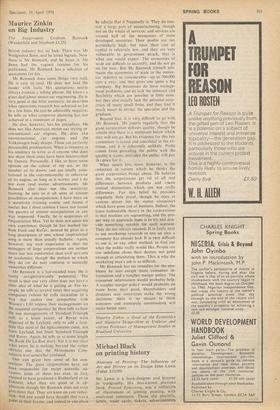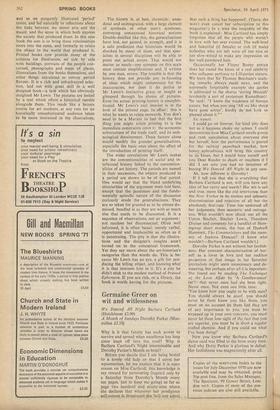Michael Black on printing history
Anatomy of Printing: The Influences of Art and History on its Design John Lewis (Faber £10.00) Mr Lewis is a book-designer and lecturer in typography. His best-known previous book. Printed Ephemera. was a collection -of illustrations of jobbing printing, with analytical comments. Those old playbills, labels, trade cards, tickets, advertisements
and so on pungently illustrated 'period' tastes, and led naturally to reflections about the links between the minor arts and the major, and the sense in which both express the society that produced them. In this new book the aim is to bring these relationships more into the open, and formally to relate the object to the world that produced it. Printed books now provide many of the' subjects for illustration, set side by side with buildings, portraits of the people con- cerned, photographs and maps of places, illustrations from the books themselves, and other things calculated to convey period flavour. It is a rich and unhackneyed selec- tion, laid out with great skill in a well designed book—a task which has obviously delighted Mr Lewis. The pictures are linked by a text which offers a historical ramble alongside them. This reads like a lecture course for art students, at any rate for art historically unsophisticated audience taken to be more interested in the illustrations. The history is, at best, chronicle: am, dotal and unintegrated, with a large element of synthesis of other men's syntheses, conveying consecrated historical notions Double-distilled like this, the generalisations have lost, not gained, in strength, and it is a safe prediction that historians would be shocked by many of them, and that spec- ialists in several disciplines will be able to point out actual errors. That would not matter so much—any synopsis on this scale must contain simplifications and, if written by one man, errors. The trouble is that the history does not provide any -re-focusing of ideas which might compensate for the inaccuracies; nor does it do justice to Mr Lewis's instinctive grasp or insight as glimpsed through his choice of pictures. Even the actual printing-history is unsophis- ticated. Mr Lewis's real interest is in the look of the printed page, its effect: this is what he wants to relate outwards. You don't need to be a Marxist to feel that the first thing you might relate printing to is the immediate constraints upon it: the economic substructure of the trade itself, and its tech- nological development. These factors alone would modify the grander generalisations, especially the basic ones about the effect of the introduction of printing itself.
The wider correlations Mr Lewis makes are the conventionalities of social and in- tellectual history linked to the convention- alities of art history. The periods are named in their succession, the objects produced in a period are shown to be of that period. One would say that the bland underlying circularities of the argument were laid bare, except that the jauntiness and the funda- mentally episodic nature of the discussion curiously erode the generalisations. They are so taken for granted as to be almost dis- missed, bundled in as they are with so much else that needs to be discounted. It is a sequence of observations, not an argument: not random but disconnected. Often well informed, it is often banal; merely verbal, opportunist and implausible as often as it is penetrating. The pity is that the illustra- tions and the designer's insights aren't turned on to the conceptual framework. Yet they say more about the art-historian's categories than the words do. This is be- cause Mr Lewis has an eye, a gift for pro- ducing the telling object, and knowing what it is that interests him in it. It's a pity he didn't stick to the modest method of Printed Ephemera. If you are rich, or a library, the book is worth having for the pictures.











































 Previous page
Previous page